Physical Address
304 North Cardinal St.
Dorchester Center, MA 02124
Athletes may suffer from chronic lower limb pain, which could be caused by peripheral nerve entrapment. Compared with other problems of the lower limb, this entity is quite rare, with a heterogeneous group of nerve disorders and multiple, sometimes very complex, etiologies and clinical presentations. Even for a perceptive clinician, distinction between the different medical causes may be difficult, given that many of their presenting features overlap. The difficulty of properly understanding the entire spectrum of peripheral nerve entrapments may lead to mis- or underdiagnosis, with an inherent risk of potential patient mismanagement. This can be frustrating for both the athlete and the treating physician. However, the approach to the problem can be facilitated by means of a structured algorithm. Adequate treatment of peripheral nerve entrapment requires a proper understanding of the anatomic course, the possible causes, precise identification of the involved nerve, and clear determination of location of compression. When adhering to the presented diagnostic rules, an optimal treatment strategy can be formulated, which should always be tailored to the athlete's pathology and needs. The current chapter attempts to provide the reader with an overview of the most important peripheral nerve entrapment syndromes found around the foot and ankle, with specific focus on athletes.
Because of its use in reconstructive surgery as a nerve graft, the sural nerve has become a well-investigated peripheral human nerve. In 1974 Pringle and coworkers were first to report on the entrapment neuropathy of the sural nerve and its clinical sequelae. This pathology may affect running athletes but also other individuals dedicated to sports The sural nerve is purely sensory and provides sensation to the posterolateral part of the distal one third of the leg and the lateral border of the foot, including the lateral aspect of the heel and the fifth toe ( Fig. 114.1 ). Communicating branches may expand the region of sensible innervation, extending it up to the third and fourth webspace. Anatomically, in 80% of cases, it arises from the distal union of the medial sural cutaneous branch of the tibial nerve and the peroneal communication branch of the common peroneal nerve. In 20% of individuals, the peroneal communicating branch is missing. In those cases the sural nerve arises as a branch from the medial sural cutaneous nerve. The medial sural nerve runs between the heads of the gastrocnemius muscle and penetrates its deep aponeurosis halfway up the leg. Anatomically the peroneal nerve anastomoses with the sural nerve. The sural nerve progresses down the border of the Achilles tendon. First it runs in midline with the calf; then approximately 10 cm above the calcaneal tuberosity, it crosses the Achilles tendon and is positioned laterally ( Fig. 114.2 ). Then the sural nerve runs approximately 1.5 cm posterior and inferior to the tip of the fibula to end up at the lateral side to the fifth metatarsal.
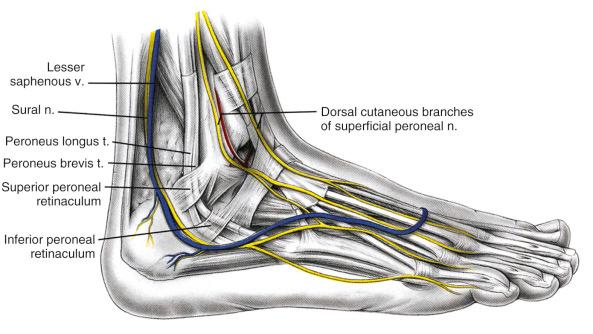
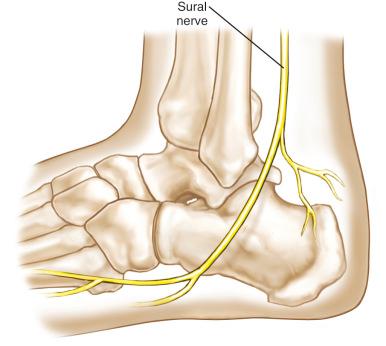
Sural nerve entrapment may happen anywhere on its course. Common sites include the lateral aspect of the heel or foot. Trauma plays a significant role as risk factor for sural nerve entrapment. Recurrent ankle sprains can cause stretching of the nerve and result in structural damage. General edema after trauma can cause external compression and impair nerve function. In addition, fractures of the base of the fifth metatarsal or ganglions of the peroneal sheaths or calcaneocuboid joint can cause nerve injury. Prior surgery at the posterior calf, Achilles tendon repair (especially percutaneous), posterolateral portals of arthroscopy ( Fig. 114.3 ), calcaneal osteotomies, ankle ligament reconstructions, peroneal tendon repairs, exposure for subtalar fusion, traction, and any scar are felt to be risk factors resulting in lesion or entrapment of the sural nerve. Less commonly, sural nerve entrapment within the gastrocnemius has been reported in the literature.
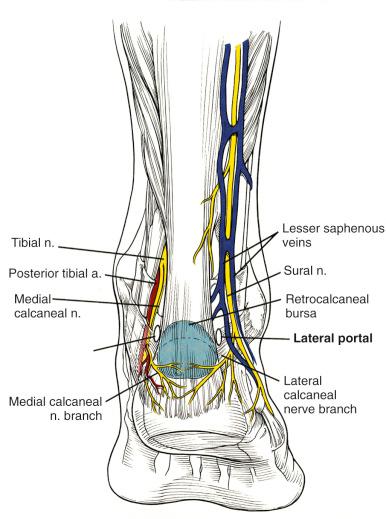
Patients may note radiating and tingling symptoms. Chronic burning, numbness, paresthesia, or aching along the course of the sural nerve specifically at the posterolateral aspect of the leg may be present, which might worsen during night or with physical activity (e.g., running).
Occasionally the spot of maximum pain allows identification of entrapment. For this purpose, examination of the entire course of the sural nerve must be performed. Local tenderness and a positive Tinel sign are identified. Inspection for possible scars from previous surgeries is mandatory. Local anesthetic injections at suspected areas help to establish the diagnosis.
S1-S2 nerve root impingement should be evaluated with a thorough lumbosacral assessment. Exertional compartment syndrome, popliteal artery entrapment, ankle sprains and Achilles tendon pathology can mimic neural entrapment.
Plain radiographs may rule out an osseous malformation that can result in compression of the nerve (e.g., hypertrophic callus formations after fracture). Some authors recommend stress views in the presence of hyperlaxity or chronic lateral ankle instability; however, the large variability in tibiotalar and anterior drawer values in both injured and non-injured ankles mitigates their value for routine use. Magnetic resonance imaging (MRI) is useful to evaluate the nerve tissue and to identify a space-occupying mass. Although computed tomography provides less detail in terms of soft tissue contents, it can be a useful adjunct when physical examination suggests an osseous structure is contributing to impingement or compression of a peripheral nerve or neurovascular bundle.
Conservative measures should be fit according to the underlying pathomechanism. Chronic ankle instability can be addressed by bracing or application of orthotics. When using those measures, it is important to ensure that no external compression applied to the nerve. In case of external compression as, for example, chronic lymphatic edema, this should be treated first. Isolated sural neuralgia might respond to vitamin B 6 , nonsteroidal antiinflammatory drugs (NSAIDs), gabapentin, tricyclic antidepressants, lidocaine patches, and/or topically applied analgesic creams.
Surgical treatment is warranted when conservative measures have failed. The surgical options include sural neurolysis or neurectomy. In case of revision nerve surgery, neurectomy with burial into healthy soft tissues or bone might be preferred rather than pure neurolysis. However, patients must be counseled about the limited results obtained in revision nerve surgery. Incisions vary according to the presence of previous incisions, the location of neuroma or entrapment, and the type of possible additional operation performed.
The patient is placed in the lateral decubitus or prone position. Both positions allow adequate access to the entire course of the sural nerve. A 10 cm skin incision is made over the area of maximum tenderness (which should be assessed prior to surgery without anesthesia). The sural nerve is identified, and the compressive structure released and/or removed. Do not perform excessive soft-tissue resection. Avoid resection of fat away from the sural nerve, as this would lead to excessive scarring and thus to a potential recurrence of entrapment.
When considering neurectomy, the nerve should be identified and dissected further distally and proximally. Then the nerve can either be stripped or transected ( Fig. 114.4A to C ). The stump can be buried into soft-tissue as, for example, muscle or into bone. Burial into bone can be difficult. To facilitate, two small unicortical drill holes (2.5 mm) are made through the cortex of the bone (e.g., fibula) perpendicular to each other. The nerve stump is inserted into one end of the bone, while a suction is placed into the other drill hole. By so doing, the nerve is drawn into the bone. It is now possible to suture the epineurium onto the periosteum. Ensure that there is no tension on the nerve, while moving the ankle up and down together with simultaneous observation of the structures involved.
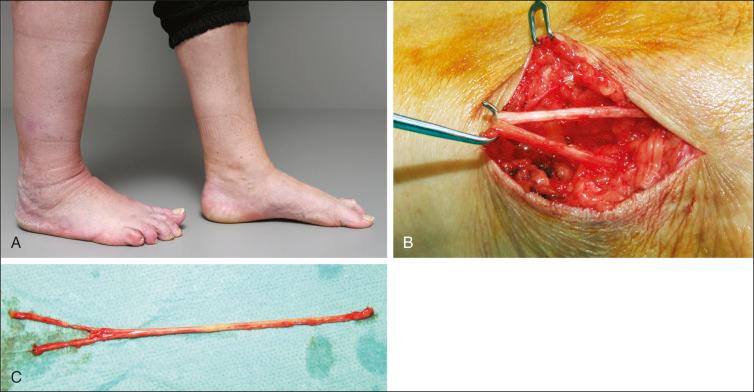
The author does not use vein wrapping procedures in case of sural nerve entrapment because of the reasonable results obtained with neurectomy.
The lower limb is put into a cast for 1 week. The cast should be put in neutral position. Walking with crutches is recommended for 1 week. After that time period, gradual resumption of weight bearing in a boot for 3 weeks as tolerated is allowed. Physical therapy, including range of motion (ROM) exercises and wobble-board training, are begun. Full athletic training can be resumed 4 to 6 weeks postoperatively. In case of extensile surgery affecting a joint or including complex osteotomies, a boot should be worn for 4 weeks and training not resumed before 8 weeks postoperatively.
In case of space-occupying lesions, resection yields satisfactory symptomatic relief. Decompression of the sural nerve by ganglia excision with neurolysis could be curative. Posttraumatic bony impingement for sural nerve entrapment can be addressed by restoring anatomy. Gould and Trevino described three cases of fractures of the base of the fifth metatarsal with dorsal displacement of the fracture fragment and tenting of the sural nerve. After reduction of the fracture fragment and neurolysis, all patients improved within several months. In a study performed by Fabre et al., 13 athletes (18 limbs) were treated due to sural nerve entrapment. Nine limbs showed an excellent result, eight limbs a good result, and one limb a fair result at time of follow-up. Ten patients had cessation of calf pain. However, in patients in whom prior surgical scarring or injury was the cause, the results of nerve release are less predictable, and may ultimately require resection and burial despite not having a true neuroma. In the presence of a neuroma, resection of the damaged nerve and burial into healthy tissue (muscle, bone) can improve symptoms. In cases of ankle instability, lateral ankle ligament reconstruction without nerve release could be enough to help the patients reduce pain and discomfort and is reasonable to perform if no neuroma is present.
Saphenous nerve entrapment is rare. The saphenous nerve is the longest sensory branch of the femoral nerve arising from the L1,2,3 nerve roots. The nerve leaves the femoral triangle to enter the adductor canal (or subsartorial canal of Hunter) together with the femoral artery and vein. The walls of the canal comprise vastus medialis and adductor longus muscle and the membrane of the vastus and adductor bridges the roof. The sartorius muscle covers the proximal portion of the canal and also covers the two terminal branches of the saphenous nerve—the infrapatellar branch and the descending branch. The infrapatellar branch supplies the sensation to the medial portion of the knee joint and the overlying anteromedial skin. The descending branch accompanies the saphenous vein to supply the skin of the medial leg and foot ( Figs. 114.5 and 114.6 ) .
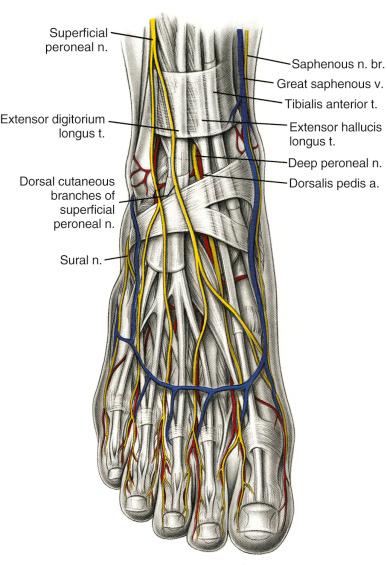
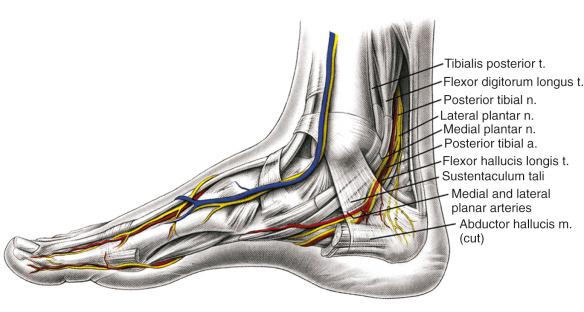
Entrapment occurs at the subsartorial fascia just proximal to the femoral condyle. Local trauma can damage the nerve. Harvesting the saphenous vein for cardiac or vascular surgery can potentially lead to damage to the saphenous nerve. Other etiologies include angulation, stretch, pressure, and friction.
Saphenous nerve entrapment can present itself in a variety of different symptoms. As a rule, symptomatology depends on site of entrapment. Proximal involvement of the saphenous nerve, (i.e., the infrapatellar branch) could result in atypical or refractory knee pain. Flexion of the knee joint might worsen the symptoms. Some patients receive incorrect knee treatment by application of a constricting brace due to missed or neglected saphenous nerve entrapment and report pain. Patients may report claudicant or exercise-related medial leg or knee pain. This syndrome has been observed in cyclists and rowers. With distal involvement of the saphenous nerve patients may feel pain, numbness, or paresthesias localized to the medial side of the leg or foot (typically proximal to the first metatarsophalangeal [MTP] joint).
The nerve should be palpated along its anatomic course starting proximally from the medial condyle of the femur and traced down the medial side of the leg and the foot. Tenderness to palpation along the course of the nerve is the hallmark of diagnosis. Tenderness at the subsartorial fascia might be found. It might be associated with a reproducible Tinel sign at the site of entrapment. Relief of pain with injection of a local anesthetic suggests localization of a more precise site of entrapment.
It is possible to use nerve conduction studies to assess the main branch of the saphenous nerve or the terminal branches. However, routine testing may not yield useful results in patients with significant subcutaneous adipose tissue or swelling of the extremity.
Electromyography for suspected saphenous nerve impingement should include testing of the adductor longus and quadriceps muscles. While electromyography is expected to be negative in saphenous nerve entrapment, it could be helpful to assess the presence of radiculopathy.
Conventional radiographs help identify posttraumatic and primary impingement on the nerve. Advanced diagnostic studies such as MRI or CT are not routinely indicated but can be considered to more clearly elucidate bony structures surrounding the course of the nerve (CT) or for preoperative planning and more precise localization of impingement in cases refractory to conservative measures.
Nonoperative treatment encompasses removal of any extrinsic factors that could lead to saphenous nerve entrapment. Activity modifications and physical therapy (strengthening exercises and proprioception) may help reduce pain. NSAIDs, topical analgesics, and systemic nerve modulators have been recommended in presence of saphenous nerve entrapment syndrome. Local injections of anesthetics with or without steroids could alleviate pain. Romanoff et al. reported an 80% success rate after a series of injections in 30 patients without application of steroids. However, if all those measures do not improve the symptoms, surgery should be considered.
Surgical treatment includes decompression, neurectomy, and neurolysis. Decompression is preferred and can be achieved by release of the anterior aspect of Hunter's canal and dissection of the saphenous nerve fibers from the surrounding sartorial fascia. Local nerve release may be necessary for more distal entrapments.
The best management for the transected proximal nerve is to bury and secure the nerve within an adjacent muscle belly. The nerve can also be compressed as it travels between the sartorius and gracilis muscles near their insertion. The nerve can either be released or divided in this region. Probably the most frequently seen problem in the sporting population is a neuroma of the infrapatellar branch. This can be irritated by repetitive movement of the knee or by direct pressure producing symptoms from the neuroma. Surgical treatment is simple. A straight incision is made over the neuroma, which is then excised, dividing the infrapatellar branch fairly proximally. In the author's experience, simple transection and placing it into muscle is all that is necessary.
A reduction or elimination of pain can be expected in 60% to 80% of cases. However, a large number of patients might still require neurectomy. There is an ongoing debate on whether neurolysis of the nerve or neurectomy achieves the best results. The chief problem with division of the saphenous nerve is the resulting distal anesthesia, with subjective discomfort in some patients. In the other hand, simple neurolysis includes complete fascial band release around the saphenous nerve with potential scar tissue formation, which could itself lead to new entrapment of the nerve. Worth et al. were able to show that in 15 patients suffering from saphenous nerve entrapment, complete relief was achieved in 13 knees after neurectomy. The authors concluded that neurectomy gave a more predictable result than neurolysis. Neurectomy should be best performed proximal to the fascia in the canal between the vastus medialis and adductor magnus.
Two patients in a study by Koppel and Thompson had relief of symptoms 24 hours after decompression. However, they were not followed up for a longer time. As such interpretation of those results is maximally limited. Dellon et al. reported the results of neurectomy in 70 patients. Of these, 62 patients were treated by neurectomy of the infrapatellar branch. Eighty-four percent revealed improvement of pain (Visual Analogue Scale).
First described by Keck and Lam in 1962, tarsal tunnel syndrome is an entrapment neuropathy involving the tibial nerve. It is relatively uncommon in athletes and thus may go mis- or undiagnosed. While nonathletic patients are often middle-aged to elderly and an equal distribution among males and females is found, in athletes the patients are younger with a tendency to female preponderance.
The tibial nerve arises from the sciatic nerve. The tarsal tunnel is located behind the medial malleolus (see Fig. 114.6 ). Its borders are created by the tibia anteriorly, the posterior process of the talus and calcaneus laterally, and the flexor retinaculum medially. The flexor retinaculum is confluent with the sheaths of the posterior tibial tendon, the flexor hallucis longus tendon, and the flexor digitorum longus tendon. The flexor retinaculum and the abductor hallucis both are frequent sites of compression. More recently, Singh et al. were able to demonstrate three well-defined, fascial septae in the sole of the foot. Two of these septae represented potential sites of compression of the posterior tibial nerve and its branches and were distinct when compared with the classic entrapment sites. In most of the cases (93%), the tibial nerve splits into three major branches within the tarsal tunnel: the medial plantar nerve, the lateral plantar nerve, and the medial calcaneal branch. The medial calcaneal branch arises from the tibial nerve in 75% to 90% of cases and in 10% to 25% from the lateral plantar nerve, and it originates proximal to the tarsal tunnel in 39%, within the tarsal canal in 34%, and distal to the tunnel in 16%. In 21% of patients, multiple calcaneal branches are found ( Fig. 114.7 ).
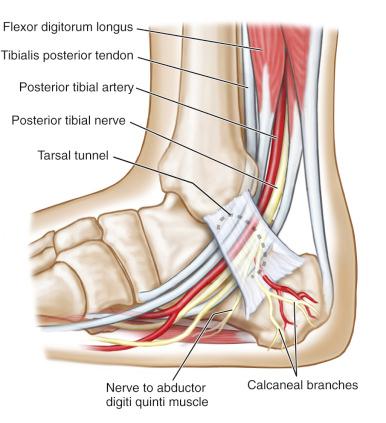
A specific cause can be identified in approximately 60% to 80% of patients. Table 114.1 provides a synopsis of the possible causes according to the work of Cimino. Engorged varicose veins, systemic diseases, neurilemmoma (benign nerve sheath tumor), pigmented villonodular synovitis, lipomas, synovial cysts, intraneural degenerative cysts, ganglion cysts (flexor hallucis longus tendon sheaths), and accessory muscles all can result in tibial nerve entrapment.
| Causes | Cases |
|---|---|
| Idiopathic | 25 |
| Traumatic | 21 |
| Varicosities | 16 |
| Heel varus | 14 |
| Fibrosis | 11 |
| Ganglion | 10 |
| Diabetes | 3 |
| Obesity | 3 |
| Tight tarsal canal | 3 |
| Hypertrophic abductor hallucis | 3 |
| Rheumatoid arthritis | 3 |
| Lipoma | 2 |
| Anomalous artery | 1 |
| Acromegaly | 1 |
| Ankylosing spondylitis | 1 |
| Regional migratory osteoporosis | 1 |
| Flexor digitorum accessorius longus | 1 |
| Subtotal | 122 |
| Causes not reported | 64 |
| Total | 186 |
Postural deformities or mechanical abnormalities may contribute to the development of tarsal tunnel syndrome. Hindfoot valgus (8% of cases) and deltoid ligament insufficiency can result in stretching of the tibial nerve and compression—as does hindfoot hyperpronation, which is typically appreciated in runners during dynamic examination of gait. More frequent hindfoot varus (11%) with a hyperpronated forefoot is often associated with tarsal tunnel syndrome. Rosson et al. found that pronation and plantar flexion significantly increased pressures in the medial and lateral plantar tunnels, to levels sufficient to cause chronic nerve compression; that a tunnel release and septum excision significantly decreased those pressures; and compared with cadaver pressures, patients had similar tarsal tunnel pressures but higher lateral plantar tunnel pressures in some positions. Preexisting chronic nerve damage, (e.g., in patients with diabetic neuropathy) may have a lower threshold for developing tarsal tunnel syndrome, when other sites of nerve compression are involved (double crush phenomenon).
Direct trauma may lead to the formation of a painful neuroma, and even scarring following an ankle sprain involving the deltoid ligament can compromise the tarsal tunnel, causing tarsal tunnel syndrome.
Symptoms can range from burning and shooting sensations, followed by paresthesia, disturbances in temperature perception, to mild loss of sensation or tingling over the heel and sole of the foot. Athletes presenting with tarsal tunnel syndrome often report plantar pain and discomfort at the medial ankle, both being aggravated during sprinting, jumping, and certain martial sports. The symptoms are usually worse during activities and improve only slowly while resting (afterburn). This is in contrast to plantar fasciitis, where pain is worst within the first steps in the morning and remits with continued activity. Some patients report pain during the night. Weakness or atrophy of intrinsic muscles will usually occur at late stage of disease.
Because of their implications regarding selection of treatment, any postural deformity should be ruled out (e.g., hindfoot valgus or varus). The entire course of the tibial nerve and its branches must be carefully palpated, and irritability, tingling, as well as any other discomfort are sought. Occasionally the Valleix phenomenon can be reproduced (tenderness proximal and distal to the entrapment site). Focusing on sensory examination alone is not sufficient because patients frequently do not suffer from sensory loss at the plantar aspect of the foot. Sensory testing of distal sensory branches using the Semmes-Weinstein monofilaments or two-point discrimination can reveal tibial nerve deficits. Motor weakness is difficult to evaluate, especially when assessing the intrinsic muscles. At times, and in case of chronic tarsal tunnel syndrome, there might be weakness of the abductor hallucis and abductor digiti quinti muscles as reflected by atrophy. Moving the ankle into maximum dorsiflexion or heel into eversion may increase symptoms due to increased tension on the tibial nerve.
Electrodiagnostic studies (nerve conduction studies; amplitude measurement; motor-evoked potential; fibrillation potentials; sensory conduction velocities) are recommended to confirm a clinically suspected tarsal tunnel syndrome and to rule out any other neuropathy in the foot. Of all electrodiagnostic studies, the sensory nerve conduction velocity is thought to be the most accurate study. The sensitivity is reported to range about 90%. Electromyography (EMG) studies of intrinsic muscles yield high rates of false positive results (10% to 43%), especially in patients older than 60 years of age. Be aware that in the presence of positive history and physical exam, a normal electrodiagnostic study does not exclude the diagnosis of tarsal tunnel syndrome.
Conventional radiography (including weight-bearing anterior-posterior views of the ankle, dorso-plantar and lateral views of the entire foot) may help to detect possible osseous alterations that could predispose to tarsal tunnel syndrome (e.g., malunited fractures of the hindfoot, coalitions, etc.). Hindfoot alignment views help estimate the amount of deformity and help prepare for any corrective intervention (e.g., supramalleolar or calcaneal osteotomies).
If there is any suspicion of a space-occupying lesion, then MRI should be taken into consideration. In a study done by Frey and Kerr in 88% of patients with suspected tarsal tunnel syndrome, a pathologic condition could be found. However, although imaging signs of direct tibial nerve dysfunction can sometimes be found, it is more likely that the tibial nerve will appear normal on imaging when no specific focal masses are present.
Ultrasound (US) examination offers the possibility to visualize even smaller nerve branches and allows detection of nerve thickening with higher spatial resolution; however, it remains highly examiner dependent.
In the absence of any lesion that could lead to nerve entrapment, nonoperative measures are recommended as the first line of treatment. If, despite adequate nonoperative measures, no improvement is found, then simple tarsal tunnel release may be warranted. However, in the presence of a space-occupying lesion within the tarsal tunnel, surgical treatment is preferred. The identifiable lesion that compresses the tibial nerve should be evaluated for and the mass removed. In case of a specific deformity or adjacent pathology that is responsible for any tarsal tunnel symptoms, this should be addressed and be either resected or corrected to achieve realignment of the hind- and forefoot, respectively.
Nonoperative measures include applications of NSAIDs to reduce the inflammatory response, oral vitamin B6, and tricyclic antidepressants (imipramine, nortriptyline, desipramine, amitriptyline). In addition, selective serotonin reuptake inhibitors (sertraline, paroxetine, duloxetine) or antiseizure drugs (gabapentin, topiramate, pregabalin, carbamazepine) can be used to improve symptoms.
Neuropathic pain does not respond to NSAIDs; however, they may reduce the inflammatory response (i.e., tenovaginitis) and therefore the soft-tissue volume within the tarsal tunnel.
Tricyclic antidepressants (amitriptyline, nortriptyline, desipramine, or imipramine) have a low number needed to treat (3.6) to achieve at least moderate pain reduction. They are well established and low priced; however, they have a high rate of side effects. Starting dosage should be low (10 to 25 mg/d administered in the evening because somnolence is one of the potentially encountered side effects). Daily intake can be increased weekly by 25 mg; however, success should not be judged until 2 weeks after the last rise. Do not exceed a maximal dosage of 100 mg/d (or 75 mg/d in the elderly) due to risk of cardiac arrhythmias and sudden cardiac death.
Good evidence exists—and therefore this kind of treatment is often advised as first-line medication—for anticonvulsants such as gabapentin (starting at 3 × 100 mg/d [first dose at night], target dose 1200 to 2400 mg/d [max 3600 mg/d]) and pregabalin (starting at 1 × 25 to 50 mg/d [at night], target dose 150 to 300 mg/d [max 2 × 300 mg/d]).
For local therapy, lidocaine patches (5%; 1 to 3/d) are recommended as second-line treatment due their good safety profile and tolerance. The alternatives are capsaicin patches (8%; 1 to 4/3 months) with good evidence. However, concerns exist with sensation disturbances during long-term use.
For opioids, a third-line recommendation is given. Usually the drugs are recommended in patients with contraindications to anticonvulsants or tricyclic antidepressants. Only in case of a positive response should the therapy be extended over more than 3 months.
When feeling uncomfortable with administration of those medications, the patient may be referred to a neurologist. Physical therapy (including desensitization therapy and nerve mobilization) is useful and might serve to break up scar tissue within the tunnel to assist in mobilization of the constricted nerve. Stretching exercises should be avoided because they could aggravate tibial nerve symptoms.
Local steroid injection into the area of the tibial nerve to reverse intraneural edema, stirrup-braces, night splints, off-the-shelf boot braces, or a short-leg walking cast may be successful means to treat tarsal tunnel syndrome. In case of any postural abnormality, orthotics could be used to place the foot in a more plantigrade position and to unload the medial longitudinal arch.
The patient is placed in the supine position. A thigh tourniquet is used and inflated up to 280 mm Hg. Alternatively, no tourniquet can be used. The advantage is that veins and arteries can easily be visualized during surgery, and thus proper hemostasis performed.
A curved incision starting 10 cm proximal to the tip of the medial malleolus and 2 cm posterior to the tibial margin is done and directed distally crossing the course of the posterior tibial tendon to end up over the midportion of the abductor hallucis longus muscle ( Fig. 114.8A ). The flexor retinaculum is exposed bluntly to avoid injury of calcaneal nerve branches. Then the retinaculum is released. In the distal aspect of the tarsal tunnel, the retinaculum becomes dense and taut. Therefore a curved clamp can be inserted and the retinaculum incised, while protecting underlying neurovascular structures from inadvertent injury. After release of the retinaculum, the tibial nerve is explored proximally by blunt dissection and traced distally until reaching the bifurcation of branches. The medial plantar nerve is followed distally around the medial malleolus and beneath the abductor hallucis muscle belly (see Fig. 114.8B ). At this point, there is a fibrous tunnel or septum that needs to be split to release the nerve branch. Be careful because large veins accompany the nerve on its course distally into the foot. The lateral plantar nerve is traced distally and slightly posterior to the medial malleolus. Quite frequently the nerve can be identified at the edge of the abductor hallucis. The superficial fascia over the muscle is released. The abductor is reflected plantarly and the deep fascia of the abductor released to relieve the first branch of the lateral plantar nerve. The lateral plantar nerve provides the nerve to the abductor digiti minimi muscle. Frequently, this nerve leaves the lateral plantar nerve before the latter passes under the abductor hallucis muscle belly. The medial calcaneal branch is identified (originating most often from the posterior tibial nerve but in 10% to 21% from the lateral plantar nerve). Any constricting tissue should be released. When there is additional hindfoot malalignment, then this should be corrected ( Fig. 114.9A and B ). Take the tourniquet down prior to closure and obtain meticulous hemostasis to prevent new compression.

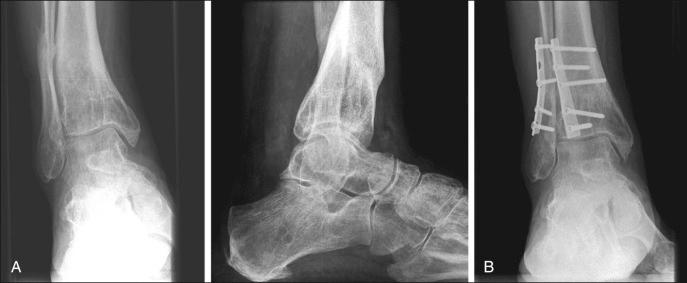
In case of so-called adhesive neuralgia (pain from a nerve scarred to surrounding tissue), a revision nerve release should be done first. This is a very delicate procedure, as the nerve could be tethered very closely to the scar and thus be damaged during preparation. The saphenous vein is harvested and its small side branch vessels tied off. Usually the entire saphenous vein must be harvested up to the knee. The ends of the vein are tied and the vein filled with a Marcaine and saline solution. Afterward, the vein is cut longitudinally and wrapped around the nerve. The inner lumen should be placed to the nerve's side. Each turn is secured by means of a simple suture using 7-0 Vicryl. After wrapping, the surgeon must ensure that there is no binding of the wrap and nerve.
After complete decompression of the tibial nerve, a non-weight-bearing short leg cast should be applied in neutral position for 2 weeks. Afterward, the cast is removed and the patient encouraged returning to activities of daily living without having any rehabilitation. Return to sports activities is allowed 3 months after the operation.
When a well-localized lesion is present (e.g., lipoma, a ganglion, etc.), the clinical results are quite satisfactory in terms of symptomatic relief. Simple tarsal tunnel release is successful in approximately 75% of these patients. Twenty-five percent obtain little or no relief. However, considering all cases of tarsal tunnel syndrome, there are many studies in the literature proving the unpredictable character of surgically performed tarsal tunnel release. The presence of a positive Tinel sign was attributed a positive predictive value of outcome after surgical release.
In a review of 24 articles, including 122 patients, Cimino was able to show that in 91% of all cases, tarsal tunnel release achieved a good and improved result. Seven percent showed poor results, and in 2% a recurrence had been found. Kinoshita treated 41 patients and found no functional deficit after a minimal follow-up of 24 months. The same author presented the results after tarsal tunnel release in athletes after a mean follow-up of 59 months. Twenty-two percent (4/18 patients) were not able to return to their preoperative athlete level. Sammarco and Chang presented their results of 62 patients. The duration of symptoms averaged 31 months. After a mean time interval of 9 months, the patients were able to return to their former activity level. Release performed less than 10 to 12 months after onset of symptoms was associated with better outcomes. Kim et al. have performed one of the largest studies on this topic. After a mean follow-up time of 33 years, 135 cases have been reviewed. Among them, 94 cases included tibial nerve lesions without discontinuity, which were treated by neurolysis. Eighty-one percent (76 patients) of those patients had a good-to-excellent result. Similar results have been presented by Carrel and coworkers in a series of 200 patients.
In summary, the likelihood of a satisfactory surgical result is increased in patients presenting well-defined lesions, a positive Tinel sign, and symptom interval less than a year of duration.
One of the problems with lateral plantar nerve entrapment (including the calcaneal branches) is that it can mimic “nonspecific heel pain” and subsequently mislead treating physicians. The diagnosis is mainly based on clinical findings. Among all patients who suffer from chronic unresolving heel pain, up to 20% are thought to have an entrapment of the first branch of the lateral plantar nerve. Although it is often termed the “inferior calcaneal branch” or the “Baxter's nerve,” the nerve may arise directly from the tibial nerve. There is no predominance regarding the activity level of the affected individuals. Most frequently, runners and joggers are affected by this kind of pathology, with a young and male preponderance (80% to 90%). Other sports activities related to the problem include soccer, dance, baseball, basketball, and tennis.
Anatomically, the first branch of the lateral plantar nerve runs between the fascia of the abductor hallucis muscle and the quadratus plantae in an oblique direction. The first branch then divides into three branches that innervate the periosteum of the medial process of the calcaneal tuberosity, the flexor digitorum brevis muscle, the plantar ligament, and the abductor digiti minimi muscle. Note that no sensory cutaneous innervation is present.
Przylucki and Baxter both located the site of entrapment of the first branch of the lateral plantar nerve between the fascia of the abductor hallucis muscle and the medial plantar margin of the quadratus plantae. Excessive pronation can cause stretching of the nerve branch. An edema within the abductor hallucis muscle as a result to repetitive stress or inflammation from chronic pressure can augment pressure within the compartment and compromise the nerve as it courses underneath the plantar ligament or at the osseous canal between the calcaneus and the flexor digitorum brevis. Other causes encompass hypertrophy of the quadratus plantae muscle, accessory muscles, and abnormal bursae and phlebitis within the venous system (see Fig. 114.7 ).
More proximal and distal nerve entrapments must be excluded. Patients report chronic heel pain, which is aggravated during walking and running. Patients may recall heel pain in the morning when taking their first few steps, as plantar fasciitis may be concomitant. However, typically pain is progressively increasing through the day, possibly due to engorgement of the veins accompanying the first branch of the lateral plantar nerve. The pain radiates from the medial inferior aspect of the heel proximally into the medial area of the ankle, or laterally and plantar into the foot. In contrast to patients with plantar fasciitis, whose pain is more directly plantar, the presence of a more medial location of pain is typical for this condition.
In case of calcaneal nerve entrapment, the diagnosis is a little bit more difficult to establish because there is variation regarding location, origin, and course. Despite this, physicians are confronted with the fact that sometimes a medial calcaneal nerve branch might arise from the medial plantar nerve.
Become a Clinical Tree membership for Full access and enjoy Unlimited articles
If you are a member. Log in here